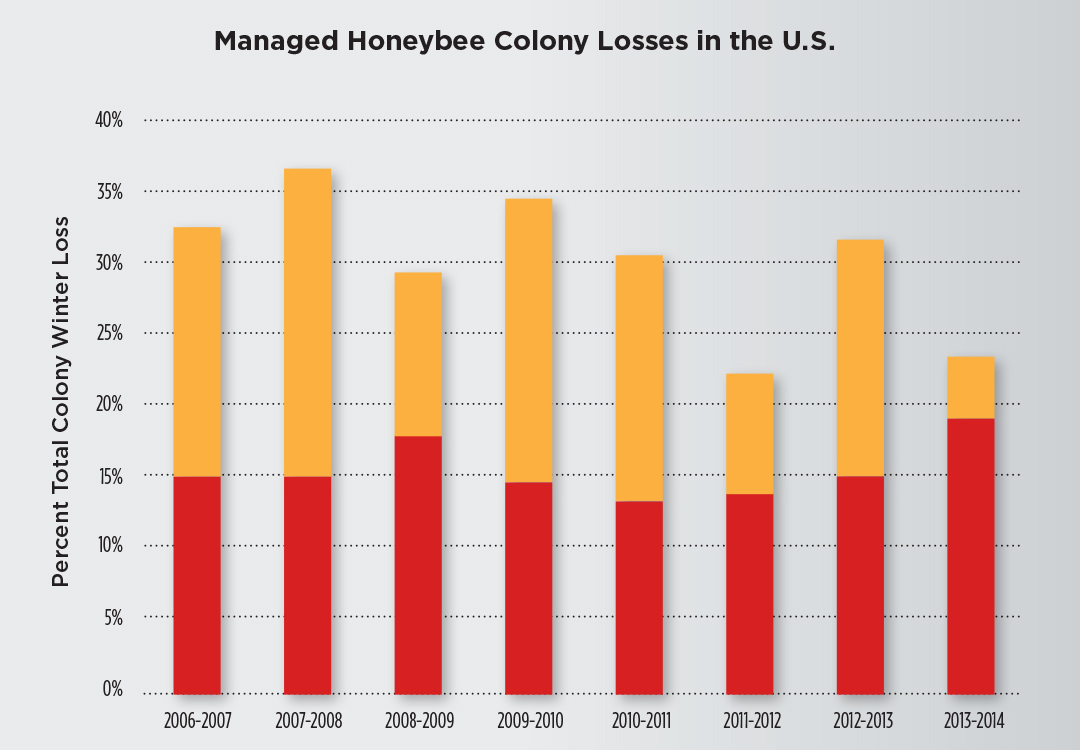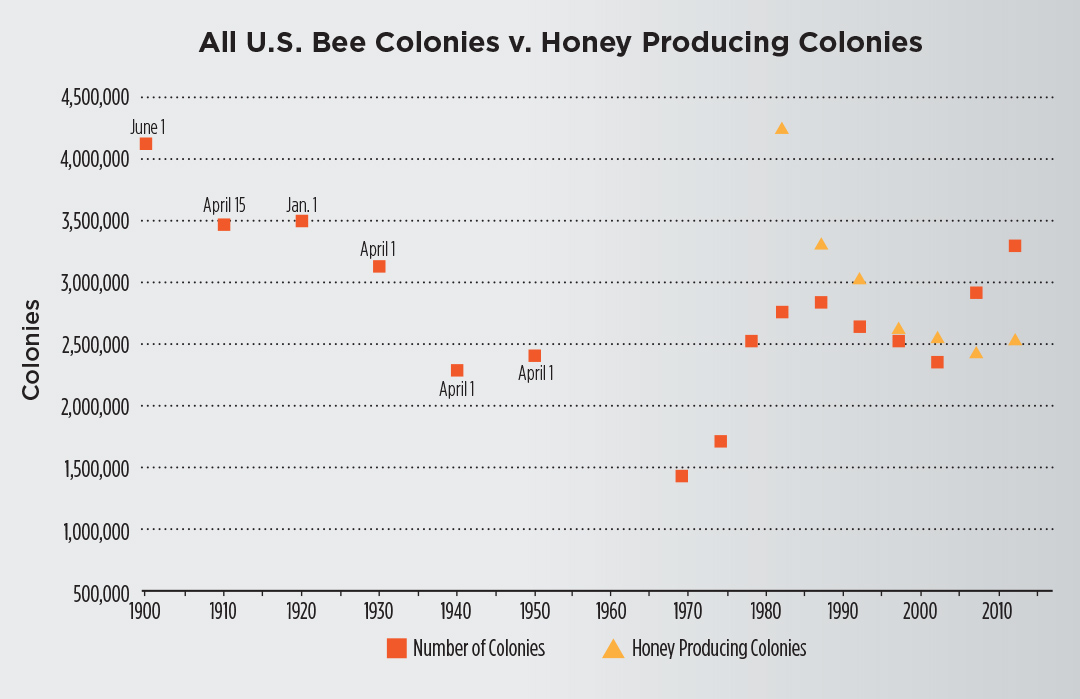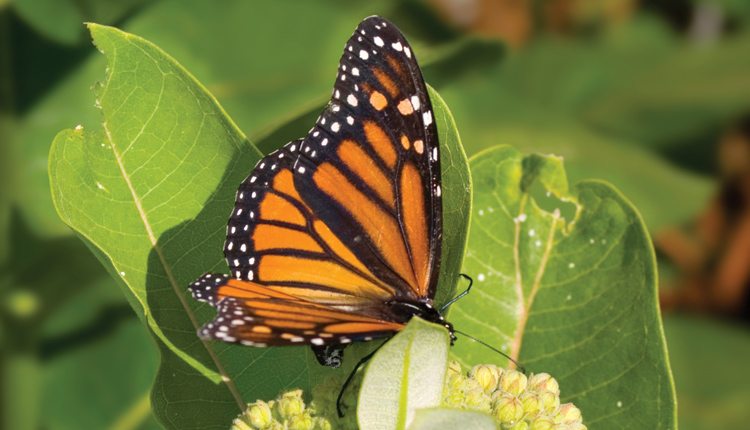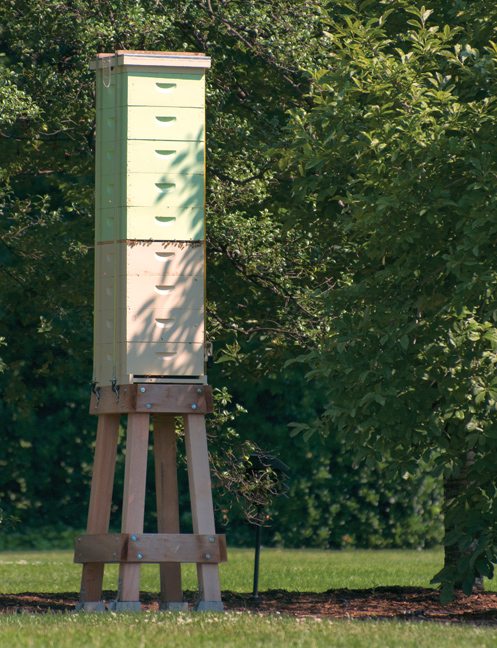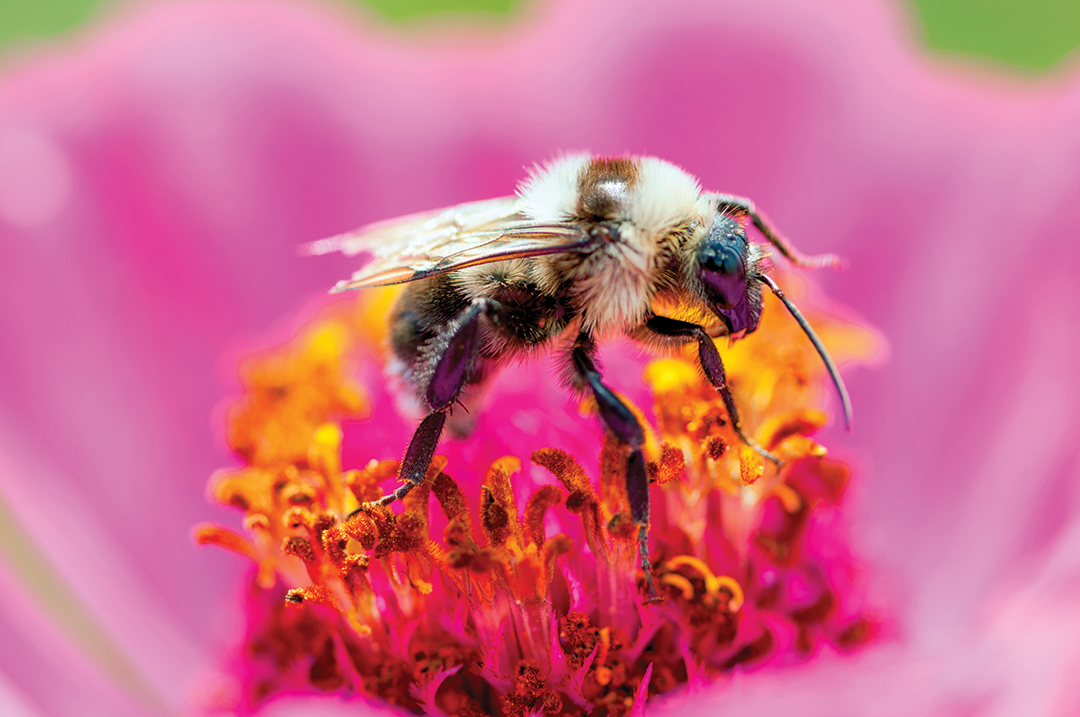The White House releases a national strategy for improving the health of honeybees and other pollinators.
A “National Strategy to Promote the Health of Honey Bees and Other Pollinators,” released by the White House May 19, outlines a comprehensive approach to tackle and reduce the multitude of stressors affecting pollinator heath.
Pollinators are not only crucial to the nation’s food supply, but its environmental and financial health. They are responsible for one in every three bites of food eaten by humans. And each year pollinators are responsible for increasing the value of the U.S. crop by more than $15 billion.
Meanwhile, nearly three-fourths of all native plants require pollination, most often by an insect and usually that insect is a native bee.
The White House outlined three goals for its national strategy:
- Reduce honeybee colony losses to economically sustainable levels.
- Increase monarch butterfly numbers to protect the annual migration.
- Restore or enhance millions of acres of land for pollinators through combined public and private action.
To achieve these goals, the strategy addresses pests and pathogens, reduced habitat, lack of nutritional resources and exposure to pesticides. Habitat and exposure to pesticides are two areas that have the most potential to impact the seed industry.
With the exception of the past two years, globally, pollinator health has been in serious decline for more than a decade. To help revive pollinator populations, the strategy is designed to not only promote the health of honeybees and other managed pollinating insects, but also expands and adds to actions already being undertaken by federal departments and agencies to reverse pollinator losses and restore populations.
The strategy focuses on expanding the conversation through enhanced public education and outreach, as well as strong public/private partnerships.
In its efforts, the White House seeks to engage all segments of society to work together to increase pollinators.
Pesticide Technologies
Pesticides play a critical role in agricultural production, and mitigating the effects of pesticides on bees is a priority for the federal government, as bee pollination and insect control are essential to the success of agriculture.
Rick Keigwin, director of the Environmental Protection Agency’s Office of Pesticide Programs, Pesticide Re-Evaluation Division, says seed treatments and pesticide exposure are big components of the national pollinator strategy.
“We have been doing a lot of work during the past couple of years to try to bring together different aspects of the federal government with private sector industry and land-grant universities to develop best management practices related to treated seed,” Keigwin says.
In addition, the agency works to identify the current state of technology in seed coatings.
“We are looking at what technology is available and what new technology has advanced to the commercial market place,” Keigwin says, noting that this helps them identify the best possible practices to reduce exposure to pollinators.
For example, he says a new lubricant that can be added to the planting hopper has become available and initial studies show it reduces dust, thus reducing pesticide exposure.
EPA is also working with equipment manufacturers internationally to develop new standards in equipment to reduce dust emissions.
Keigwin says the EPA, in its registration review, is looking at seed treatments to determine what changes might be necessary.
“While we haven’t completed the risk assessment, we are looking at some of these new technologies to reduce exposure and the benefits to growers in using this technology,” he explains.
Jane DeMarchi, American Seed Trade Association vice president of government affairs, says while “we don’t know exactly what the national pollinator strategy means for the seed industry, there is potential for some positive opportunities as far as programs put in place to increase pollinator habitat.”
The strategy has many moving parts with many federal agencies involved. In addition, there are opportunities for the private sector when it comes to pollinator friendly seed mixes, she says.
As research information is submitted to EPA, like many companies, ASTA is waiting to see what actions they propose and are ready to address them.These actions could range from spraying pesticides to the number of federal dollars put toward increasing acreage of new habitat and forage.
“The plan is meant to be a long-term strategy,” DeMarchi says.
While seed companies might not know exactly how the strategy is going to impact them, many have already taken proactive measures to improve health and vitality of pollinators.
A few of these efforts include increasing habitat, communication and outreach initiatives and new partnerships.
Increasing Habitat
Increasing the quality and quantity of habitat for pollinators is also a major part of the national strategy.
Habitat quality and quantity are central to the health of pollinator populations and ecosystems, and the well-being of our society is dependent on these resources, according to the strategy. The federal role on expanding and improving pollinator habitat will be through the large variety of facilities and acreages of land managed by the federal government and indirectly through the leadership role that federal agencies play in interactions with states, localities, the private sector and citizens.
Caydee Savinelli, pollinator and integrated pest management stewardship lead at Syngenta, says there are two big things in the strategy that impact the seed industry — increasing high-quality, diverse forage for honeybees and other pollinators and increasing the monarch butterfly population.
Savinelli, who is an entomologist by training, says monarchs and honeybees prefer much of the same forage. While monarchs love milkweed, they also love other flowers, so increasing habitat and forage is usually beneficial for both, she explains.
Increasing forage and habitat is key for companies such as Syngenta and Bayer CropScience.
“We have to look at it from a holistic approach,” says Becky Langer, Bayer CropScience North American bee care manager. “Bayer has historically had strong research efforts in the areas of bee health and forage habitat.”
She says the national strategy offers a great road map for all stakeholders — whether that’s beekeepers, scientists or consumers buying garden plants.
One of Bayer’s initiatives to increase forage health is its Feed a Bee campaign. Langer explains that Feed a Bee focuses on consumers and landowners.
The initiative has been popular. When Bayer started handing out seed packets to help promote its goal to plant 50 million flowers in a year, it hit the mark in just five weeks.
In addition, the North American Bayer Bee Care Center hit 3,000 visitors in its first week.
“You know the topic is popular, but until you see folks come in, you don’t realize how popular it is,” Langer says.
In North Carolina, where Bayer’s headquarters are located in Research Triangle Park, the company has worked to plant pollinator friendly roadsides. And in Kansas, it worked to plant five, 15-acre plots on a dairy farm that supplies milk to Dannon in Florida.
In partnering with other organizations, such a Project Apis m., a California nonprofit, Bayer has worked to provide quality forage in almond groves and is now looking at apple groves.
Additionally, Syngenta’s Operation Pollinator program for more than 10 years has taken marginal agricultural land not being used for crops and incorporates flowering plants.
The program works with different conservation groups in the agricultural space and has done research with the University of California, Davis, Michigan State University and the University of Florida on group pollination.
Through its Operation Pollinator program, Syngenta also collaborates with Applewood Seed Company in Arvada, Colo., to provide golf courses with custom-blends of wildflower seed native to the region.
Norm Poppe, Applewood Seed Company general manager, says his company has been actively in engaged on the national pollinator strategy at many levels.
Whether it be participating with the Honey Bee Health Coalition or helping ASTA with pollinator plans, Applewood Seed Company has its own diverse mix of seeds for all kinds of pollinators, including native bees, honeybees and monarch butterflies.
It has supplied seeds for a range of federal programs, state highway programs and at the consumer level.
“The emphasis on pollinators and the decline in their health has been a strong topic for us in trying to develop products and advise on research to produce and provide better quality products,” Poppe says.
He is glad to see the emphasis on pollinator health and is ready to see things start happening.
Poppe hopes the White House will push for increased funding to help plant more forage for all the various pollinators.
Applewood Seed Company has been actively involved in researching mixtures since 2007. At that time, pollinators were a secondary part of what the company did, which was to focus on flower seeds with an ornamental purpose. However, after 2007 when they saw the need for more functional landscapes, Poppe’s team found that ornamental and functional fit together quite well.
“We’ve been actively involved in identifying what pollinators are attracted to and what seeds we sell,” Poppe says. For the past eight years, Applewood has been working on that research and developed subsets attractive to monarchs and tailored to honeybees. It has also developed mixtures tailored to general pollinators, such as native bee, flies and hummingbirds.
A significant consideration is pollinators differ — from their mouths to the size of head that allow them to feed on nectar pollinate.
“They need to fit certain flowers,” he explains. “Some species aren’t attracted to or physically can’t feed on them. So, these seed mixes need to be tailored specifically to the insect you are trying to attract.”
Outreach, Education and Communication
Applewood Seed is also working on an education component that will share the research they’ve done the past eight years with others in the industry.
“We’ve gathered a lot of information, but have found the topic of forage and nutrition for pollinators is not a subject a lot of people are well versed on,” he says. “We are sharing what we’ve learned with a larger population, whether that be a seed company putting information on its packet or a seed distributor selling seed to golf courses.”
Additionally, Applewood Seed Company is working with highway departments to provide a better understanding of what mixes would perform well on a roadside with mowing schemes.
Bayer, too, participates in hundreds of events from talks at universities to field days, conventions and trade shows. For its employees, it offers a bee ambassador program.
Bayer believes pollinator health is an area everyone can get involved with and continually improve, asking for community feedback to help shape the future of its program.
Savinelli adds that Syngenta works with state pesticide education programs that in turn influence programs run by local Extension educators, who in turn work with farmers.
“Really, the No. 1 thing to know is what insect you’re targeting and what is causing the problem,” Savinelli says.”
When it comes to seed treatments, seed companies and other groups are working to minimize dust that occurs at application, looking into using different equipment and timing.
Communication is key for success. “If you have beekeepers in the area, they may want to keep their bees somewhere else so they don’t get exposed to pesticides,” Savinelli says. “It is the exposure that puts bees in harm’s way.”
Syngenta continues to conduct studies, submitting results to EPA.
“It’s important to look at field studies,” Savinelli says. “For example, in Canada, beekeepers bring their bees to canola fields, in which 90 to 100 percent of those seeds are treated with neonicotinoids.
“It is a good food source and in my mind, it tells me there isn’t a problem with the plants that come from seeds treated by neonicotinoids.”
When it comes to pesticides, Bayer’s CARE (Communicating, Awareness, Reducing, Ensure) Program has communication at its center. It is important beekeepers and growers communicate with each other, being sure there is awareness about wind and potential for drift, reducing the potential for exposure and ensuring equipment is working properly, Langer says.
She adds that Bayer has worked with equipment manufacturers to find ways to prevent dust from coming off equipment. The company also looks into new products — one with a focus on bee repellency.
To further these efforts, ASTA, in partnership with other organizations, launched the Million Pollinator Garden Challenge to help increase pollinator habitat.
Meanwhile, ASTA conducts outreach within the seed industry and among farmers to increase seed treatment stewardship and make sure the active ingredients on the seeds do what they are supposed to and that growers are buying high quality seed.
Seed treatments offer farmers many benefits and ASTA will continue its involvement in the process until the EPA registration review process wraps up in 2017.
Working Together
Companies such as Applewood, Bayer and Syngenta are working together to improve the health of honeybees as part of the Honey Bee Health Coalition.
Julie Shapiro, Honey Bee Health Coalition facilitator, and senior associate of The Keystone Policy Center, says the diverse, multi-sector coalition brings groups together, including beekeepers, researchers, government agencies, agribusinesses, growers, conservation groups, manufacturers and consumer brands. Together, these groups improve the health of honeybees in general and specifically around production agriculture.
“Our mission is to collaboratively implement solutions that will help to achieve a healthy population of honeybees while also supporting healthy populations of native and managed pollinators in the context of productive agricultural systems and thriving ecosystems,” Shapiro says.
The coalition advances initiatives to address the multiple factors that influence honeybee health, including hive management, forage and nutrition, crop pest management and education.
“Our work aligns with the national strategy’s goal of restoring and enhancing 7 million acres of pollinator habitat, federal actions and public-private partnerships,” she says.
The coalition submitted science-based recommendations to the task force, emphasizing the need for research and development. In addition, it encourages members to promote agricultural practices that benefit pollinators and other insect groups.
The coalition also works to advance understanding of honeybee nutrition and the development of pre-competitive solutions for improving honeybee nutrition supplements. In addition, it is advancing communication, education and solutions across its diverse stakeholders to control crop pests while safeguarding pollinator health.
Strategy Remains Exploratory in Scope
If you find yourself wondering exactly what the details are, much of the recommendations are still in the exploratory phase — thus, the many unknowns.
One such recommendation that has the potential to increase demand for pollinator mixes is the possible expansion of the Conservation Reserve Program (CRP) to benefit pollinators. According to the strategy, CRP currently has more than 24 million acres enrolled nationwide, including more than 1 million CRP state acres for wildlife enhancement and other continuous CRP practices that provide enhanced pollinator habitat with diverse cover types. As part of the strategy, the Farm Service Agency (FSA) will review its CRP practices to identify those practices that are already beneficial to wild pollinators and managed bees, and where additional pollinator plantings can be included.
CRP Acres for Pollinators
Meanwhile, FSA has more than 124,000 acres currently enrolled in a special CRP category for practicing enhanced pollinator habitat (CP-42), and has allocated an additional 76,000 acres of land specifically for that practice.
Practices that qualify for CP-42 include planting native plant species and a variety of plants that flower at different times of the growing season to provide a diversity of pollen sources necessary for bee nutrition and health. FSA is monitoring the effectiveness of CP-42 enrollments and other CRP practices to document and quantify the benefits to pollinators. Depending on data and stakeholder feedback, new practices and acres could be added to the program.



